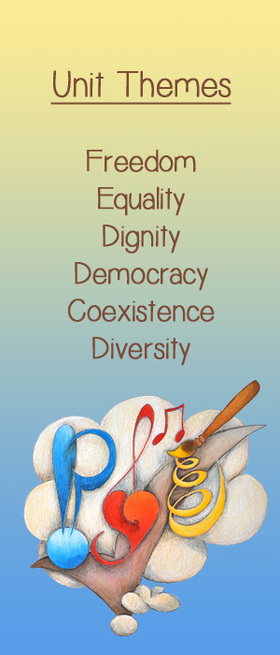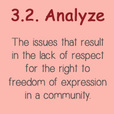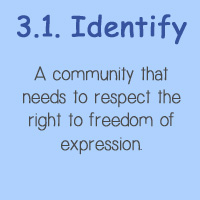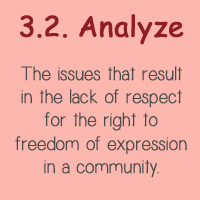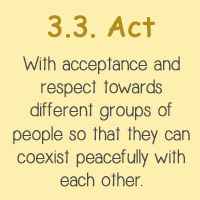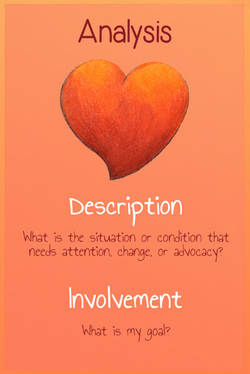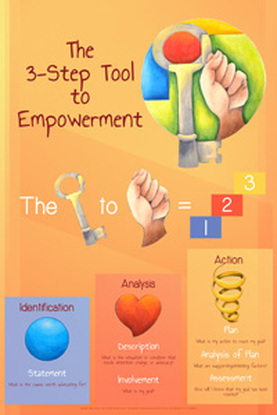Classroom Learning Activities
|
1. Analyze a Community's Need to the Right to Freedom of Expression
Students refer to the 3-Step-Tool to Empowerment to analyze a cause worth advocating for that relates to a community's obligation to democratic participation through freedom of expression in the community. This includes the following process:
|
Values of respect for the right to expression guides the child when analyzing a cause and setting a goal worth advocating for.
|
Relevant Convention Articles
Article 12
1. States Parties shall assure to the child who is capable of forming his or her own views the right to express those views freely in all matters affecting the child, the views of the child being given due weight in accordance with the age and maturity of the child.
2. For this purpose, the child shall in particular be provided the opportunity to be heard in any judicial and administrative proceedings affecting the child, either directly, or through a representative or an appropriate body, in a manner consistent with the procedural rules of national law.
Article 13
1. The child shall have the right to freedom of expression; this right shall include freedom to seek, receive and impart information and ideas of all kinds, regardless of frontiers, either orally, in writing or in print, in the form of art, or through any other media of the child's choice.
2. The exercise of this right may be subject to certain restrictions, but these shall only be such as are provided by law and are necessary:
(a) For respect of the rights or reputations of others; or
(b) For the protection of national security or of public order (ordre public), or of public health or morals.
Article 14
1. States Parties shall respect the right of the child to freedom of thought, conscience and religion.
2. States Parties shall respect the rights and duties of the parents and, when applicable, legal guardians, to provide direction to the child in the exercise of his or her right in a manner consistent with the evolving capacities of the child.
3. Freedom to manifest one's religion or beliefs may be subject only to such limitations as are prescribed by law and are necessary to protect public safety, order, health or morals, or the fundamental rights and freedoms of others.
Article 15
1. States Parties recognize the rights of the child to freedom of association and to freedom of peaceful assembly.
2. No restrictions may be placed on the exercise of these rights other than those imposed in conformity with the law and which are necessary in a democratic society in the interests of national security or public safety, public order (ordre public), the protection of public health or morals or the protection of the rights and freedoms of others.
Article 17
States Parties recognize the important function performed by the mass media and shall ensure that the child has access to information and material from a diversity of national and international sources, especially those aimed at the promotion of his or her social, spiritual and moral well-being and physical and mental health.
To this end, States Parties shall:
(a) Encourage the mass media to disseminate information and material of social and cultural benefit to the child and in accordance with the spirit of article 29;
(b) Encourage international co-operation in the production, exchange and dissemination of such information and material from a diversity of cultural, national and international sources;
(c) Encourage the production and dissemination of children's books;
(d) Encourage the mass media to have particular regard to the linguistic needs of the child who belongs to a minority group or who is indigenous;
(e) Encourage the development of appropriate guidelines for the protection of the child from information and material injurious to his or her well-being, bearing in mind the provisions of articles 13 and 18.
1. States Parties shall assure to the child who is capable of forming his or her own views the right to express those views freely in all matters affecting the child, the views of the child being given due weight in accordance with the age and maturity of the child.
2. For this purpose, the child shall in particular be provided the opportunity to be heard in any judicial and administrative proceedings affecting the child, either directly, or through a representative or an appropriate body, in a manner consistent with the procedural rules of national law.
Article 13
1. The child shall have the right to freedom of expression; this right shall include freedom to seek, receive and impart information and ideas of all kinds, regardless of frontiers, either orally, in writing or in print, in the form of art, or through any other media of the child's choice.
2. The exercise of this right may be subject to certain restrictions, but these shall only be such as are provided by law and are necessary:
(a) For respect of the rights or reputations of others; or
(b) For the protection of national security or of public order (ordre public), or of public health or morals.
Article 14
1. States Parties shall respect the right of the child to freedom of thought, conscience and religion.
2. States Parties shall respect the rights and duties of the parents and, when applicable, legal guardians, to provide direction to the child in the exercise of his or her right in a manner consistent with the evolving capacities of the child.
3. Freedom to manifest one's religion or beliefs may be subject only to such limitations as are prescribed by law and are necessary to protect public safety, order, health or morals, or the fundamental rights and freedoms of others.
Article 15
1. States Parties recognize the rights of the child to freedom of association and to freedom of peaceful assembly.
2. No restrictions may be placed on the exercise of these rights other than those imposed in conformity with the law and which are necessary in a democratic society in the interests of national security or public safety, public order (ordre public), the protection of public health or morals or the protection of the rights and freedoms of others.
Article 17
States Parties recognize the important function performed by the mass media and shall ensure that the child has access to information and material from a diversity of national and international sources, especially those aimed at the promotion of his or her social, spiritual and moral well-being and physical and mental health.
To this end, States Parties shall:
(a) Encourage the mass media to disseminate information and material of social and cultural benefit to the child and in accordance with the spirit of article 29;
(b) Encourage international co-operation in the production, exchange and dissemination of such information and material from a diversity of cultural, national and international sources;
(c) Encourage the production and dissemination of children's books;
(d) Encourage the mass media to have particular regard to the linguistic needs of the child who belongs to a minority group or who is indigenous;
(e) Encourage the development of appropriate guidelines for the protection of the child from information and material injurious to his or her well-being, bearing in mind the provisions of articles 13 and 18.
Online Resources and References
- Ayahuasca-Wasi Retreats - Non-Violent Communication: Extracts from Marshall Rosenberg Books. Retrieved from: http://www.ayahuasca-wasi.com/english/articles/NVC.pdf.
- Bucket Fillers - Growing up with a bucket full of happiness. Also, here are book activities.
- Canadian International Development Agency (CIDA) Child Protection Unit - Evolving Capacities and Participation by Gerison Lansdown. Also by Gerison Lansdown - Evolving Capacities and the Exercise of Rights (April, 2013).
- Child Rights International Network - Children's Rights and Freedom of Expression.
- Clay, Bob. (2006). Nonviolent Communication. Loch Arthur Community, Scotland.
- Higgins, Jennifer Johnson. (N.D.). School of Education at Johns Hopkins University-Multicultural Children's Literature: Creating and Applying an Evaluation Tool in Re
- Katherine Covell, PhD - Listening to our children (2010): In our hurried world, it is common for much of the communication between parents and their children to consist of the ‘didjas.’ Didja do your homework? Didja brush your teeth? Didja put the cat out? But children have a right to much more than the didjas. The United Nations Convention on the Rights of the Child says that children have a right to have their voices heard, and to have their thoughts solicited and taken into account on matters that affect them. Children have a right to be listened to in their homes, schools, and communities. Read more...
- Humanium - Help the Children: Right to Freedom.
- Kid's Talk - Freedom of Expression and the UN Convention on the Rights of the Child.
- Rosenberg, Marshall B. Raising Children Compassionately. Retrieved from: https://www.cnvc.org/Raising-Children-Compassionately.
- UNICEF - The Convention on the Rights of the Child: Participation Rights - Having an active voice.
- UNICEF - Innocenti Insight: The Evolving Capacities of the Child.
- United Nations - Convention on the Rights of the Child: General Comment No. 12 (2009) - The right of the child to be heard.

